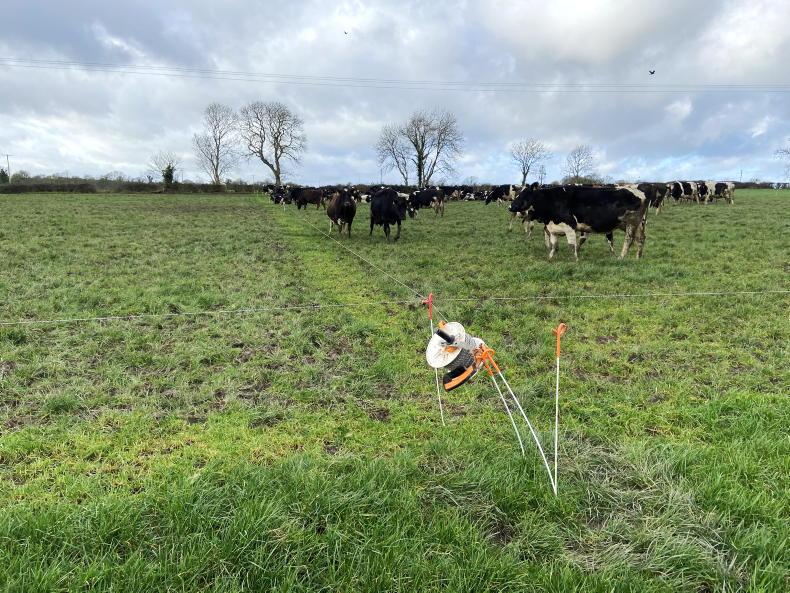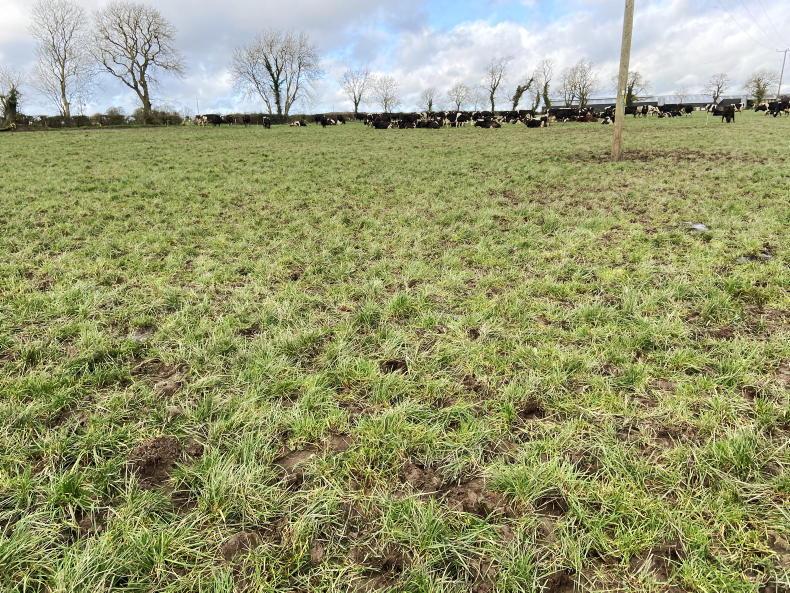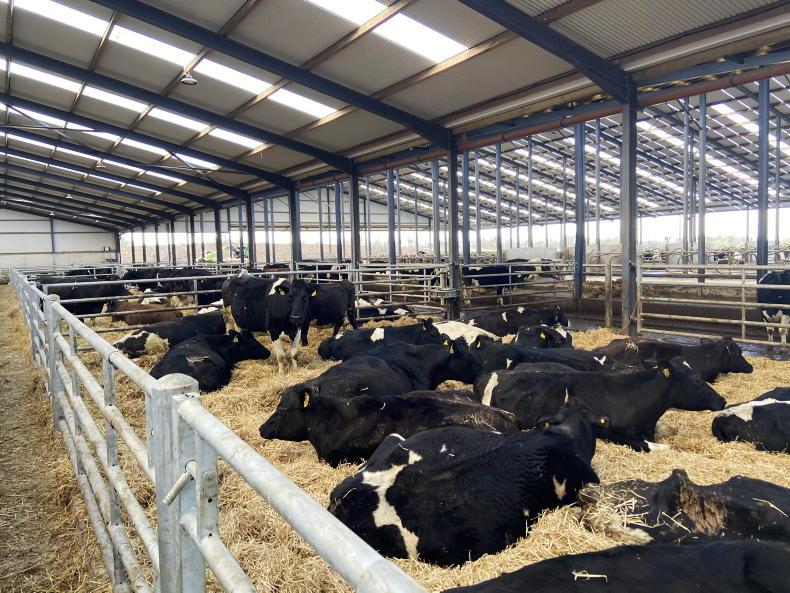The last decade has seen a 45% increase in dairy cow numbers in Co Meath.
The region has historically had the largest farm size in the country and while average herd size is not available on a county by county basis, Meath is surely up there with the highest average herd size in Ireland.
One such farm that has expanded over the last decade is the Burke farm at Corbalton, just outside Ratoath in the east of the county. Traditionally, a liquid milk herd, the Burkes were milking 330 cows in a split spring/autumn-calving system with 70% of the herd calving in spring.
The opportunity to lease land adjoining the platform, plus Neil’s preference for lower cost grass-based spring -calving systems, saw the farm change dramatically over the last four or five years.

Neil Burke, Ratoath, Co Meath.
When the Irish Farmers Journal visited the farm earlier this week, the team at Corbalton were in the thick of the action, with upwards of 15 cows calving per day on average. There are three full-timers on the farm – Johnny and Neil Burke and farm manager Niall Thynne. They are helped out by three students in spring and relief milkers and part-timers for the rest of the year.
There are 480 cows to calve this spring and as we went to press, there were almost 45% calved. The first cow was due to calve on 5 February, but the first calf was actually born on 30 January. The soil type on the farm is deep clay, and while it’s not heavy as such, it’s certainly not light.

Two hundred and ninety cubicles were built as part of the development work.
Neil and Niall look after the grazing and grassland management side of things and it’s been a bit of a struggle so far this spring. The challenges of early spring grazing are magnified when farming at scale, because gaps into and out of paddocks come under pressure much quicker.
On Monday, Neil had 7% of the farm grazed. The cows were out grazing but were doing damage and didn’t seem that interested in grass. Neil reckons they weren’t hungry enough before they went out. They had been inside the night before after severe weather over the weekend and went out to grass straight after milking. He’s been trying to keep cows out during the day by splitting the allocation in two, giving two 3kg DM/cow allocations rather than one 6kg allocation. The cows are out for a few hours after evening milking, but are then brought in.

A bit too much damage was being done on Monday last.
“Grazing has been tough going, we’re doing a bit of damage and they’re not cleaning out paddocks all that well. I’ve been grazing the fronts of paddocks, mostly because access is better and it means we’re avoiding having to use spur roads, which I don’t really like doing. The plan is to get into the backs of paddocks when conditions improve and we will back fence them then,” Neil says.
With less than 10% grazed to-date, it’s unlikely that Neil will hit the target of 30% grazed by 1 March. The fields the cows are grazing at the moment are not the driest on the farm, but the drier fields either have high covers of 1,600kg/ha or some very low covers of less than 500kg/ha, so they are currently not suitable for grazing.
The challenge now is to get more area grazed. Neil says his target is shifting more towards getting 30% grazed by 7 March, rather than 1 March, as he is calving that little bit later than most farmers further south.
While the weather is obviously going to play a huge part in getting more area grazed, it’s also worth remembering that the number of cows out grazing is increasing daily and their dry matter intake is increasing also – there is an almost exponential increase in demand at the moment.
The challenge for Neil and everyone else is to get grass into cows without doing damage. As cow numbers increase, the area per day will increase too, which makes it easier to divide paddocks – it’s much easier to give one-quarter of a paddock than it is to give one-eight of a paddock, because most breaks will have access off a roadway.

The grazed section from where the cows were on Monday. Neil wasn't happy with the damage done or the cleanout.
The other thing is to manage what feed they get in the shed. Neil reckons the cows were getting too much silage at night, which reduces their appetite for grass during the day and they end up walking around rather than grazing. Speaking to Neil on Wednesday, he said he didn’t feed any silage on Monday night and there was no damage done on Tuesday, cows were out all night, clean outs were much better and they weren’t hanging around the gap he said. Some silage will be offered when cows come in after a few hours grazing, but this will be pushed away from them a few hours before they are due to go back out grazing.
Silage quality on the farm is excellent, having been tested at 82% DMD, so if and when cows need to stay indoors, their feed intake shouldn’t suffer. We walked all of the fields grazed to-date and while there were some pockets of poaching in places, most of the damage was minimal.
However, it is sometimes easy to become accustomed to doing damage, and this is something Neil has to watch, particularly as we head towards March, when area grazed per day will be much higher than it is now.
The farm grew an average of 14.5t DM/ha last year. Some of the grass varieties are old and while pH and phosphorus levels are OK, potash is very low. A lot of the current grazing paddocks were silage fields before, hence the low K levels.
No nitrogen has been spread to-date, but the plan is to go with 23 units/ac of urea at the weekend, weather permitting. About 45% of the farm has been spread with slurry and won’t get any nitrogen in this round. Neil reckons getting ground grazed in early spring has a much bigger impact on grass growth rates than early nitrogen.
To fix the K problem, Neil plans to spread 1.5 bags/ac of 18:6:12 in March and two bags/ac of 0:10:20 later in the year, along with targeting slurry to the low K fields.
Cows
The herd produced 450kg MS/cow in 2020 from 800kg of meal. Historically, the herd was high-yielding Holstein Friesian, but this is changing fairly rapidly, with a strong focus placed by Neil on crossing the herd with Jersey.
“We were dabbling with Jersey for the last few years, using them on high-yielding cows, but invariably they didn’t go in calf or went in calf to beef. Now, we’re using Jersey across the board and some of the first cross cows will get pure Jersey a second time, because they are still quite big and milky. We have used high-EBI genomic sires in the past, but I’m increasingly looking at BW [New Zealand Breeding Worth] when picking bulls.

The calving area can hold over 90 cows and they eat on the feed passage.
“I just can’t find the bulls I want on the Irish catalogues, as they are all either too big, have poor dams or have low percentage solids. I think the size of the cow is important – my aim is for a 500kg to 520kg cow, which could mean savings of up to 20% on winter feed well, as well as having a high feed conversion efficiency,” Neil says.
The milking platform is stocked at 3.45 cows/ha and Neil says that’s as high as he’s willing to go. Through reseeding more of the farm, (35% of the platform is planned for this year) and improving soil fertility, he feels he can grow more grass and get more clover on-farm. There is currently little to no clover.
Calving
Calving is going well, with no real problems to report. A night calver is on five nights a week from 8:30pm to morning, which John and Neil say makes a huge difference and gives great peace of mind. Calves are stomach tubed straight away after being born and moved to the calf shed where they go on milk replacer after a few days. No calves have been sold yet, but the plan is to take some to the mart next week.
The Burkes have made a significant investment in buildings over the last few years, with a new 60 point Waikato parlour, Alfco drafting, 290 cubicles, a silage slab and a 90-cow calving shed built in 2019. All youngstock and silage are kept on outside land blocks. A little over 60% of the milking platform is owned land.
The last decade has seen a 45% increase in dairy cow numbers in Co Meath.
The region has historically had the largest farm size in the country and while average herd size is not available on a county by county basis, Meath is surely up there with the highest average herd size in Ireland.
One such farm that has expanded over the last decade is the Burke farm at Corbalton, just outside Ratoath in the east of the county. Traditionally, a liquid milk herd, the Burkes were milking 330 cows in a split spring/autumn-calving system with 70% of the herd calving in spring.
The opportunity to lease land adjoining the platform, plus Neil’s preference for lower cost grass-based spring -calving systems, saw the farm change dramatically over the last four or five years.

Neil Burke, Ratoath, Co Meath.
When the Irish Farmers Journal visited the farm earlier this week, the team at Corbalton were in the thick of the action, with upwards of 15 cows calving per day on average. There are three full-timers on the farm – Johnny and Neil Burke and farm manager Niall Thynne. They are helped out by three students in spring and relief milkers and part-timers for the rest of the year.
There are 480 cows to calve this spring and as we went to press, there were almost 45% calved. The first cow was due to calve on 5 February, but the first calf was actually born on 30 January. The soil type on the farm is deep clay, and while it’s not heavy as such, it’s certainly not light.

Two hundred and ninety cubicles were built as part of the development work.
Neil and Niall look after the grazing and grassland management side of things and it’s been a bit of a struggle so far this spring. The challenges of early spring grazing are magnified when farming at scale, because gaps into and out of paddocks come under pressure much quicker.
On Monday, Neil had 7% of the farm grazed. The cows were out grazing but were doing damage and didn’t seem that interested in grass. Neil reckons they weren’t hungry enough before they went out. They had been inside the night before after severe weather over the weekend and went out to grass straight after milking. He’s been trying to keep cows out during the day by splitting the allocation in two, giving two 3kg DM/cow allocations rather than one 6kg allocation. The cows are out for a few hours after evening milking, but are then brought in.

A bit too much damage was being done on Monday last.
“Grazing has been tough going, we’re doing a bit of damage and they’re not cleaning out paddocks all that well. I’ve been grazing the fronts of paddocks, mostly because access is better and it means we’re avoiding having to use spur roads, which I don’t really like doing. The plan is to get into the backs of paddocks when conditions improve and we will back fence them then,” Neil says.
With less than 10% grazed to-date, it’s unlikely that Neil will hit the target of 30% grazed by 1 March. The fields the cows are grazing at the moment are not the driest on the farm, but the drier fields either have high covers of 1,600kg/ha or some very low covers of less than 500kg/ha, so they are currently not suitable for grazing.
The challenge now is to get more area grazed. Neil says his target is shifting more towards getting 30% grazed by 7 March, rather than 1 March, as he is calving that little bit later than most farmers further south.
While the weather is obviously going to play a huge part in getting more area grazed, it’s also worth remembering that the number of cows out grazing is increasing daily and their dry matter intake is increasing also – there is an almost exponential increase in demand at the moment.
The challenge for Neil and everyone else is to get grass into cows without doing damage. As cow numbers increase, the area per day will increase too, which makes it easier to divide paddocks – it’s much easier to give one-quarter of a paddock than it is to give one-eight of a paddock, because most breaks will have access off a roadway.

The grazed section from where the cows were on Monday. Neil wasn't happy with the damage done or the cleanout.
The other thing is to manage what feed they get in the shed. Neil reckons the cows were getting too much silage at night, which reduces their appetite for grass during the day and they end up walking around rather than grazing. Speaking to Neil on Wednesday, he said he didn’t feed any silage on Monday night and there was no damage done on Tuesday, cows were out all night, clean outs were much better and they weren’t hanging around the gap he said. Some silage will be offered when cows come in after a few hours grazing, but this will be pushed away from them a few hours before they are due to go back out grazing.
Silage quality on the farm is excellent, having been tested at 82% DMD, so if and when cows need to stay indoors, their feed intake shouldn’t suffer. We walked all of the fields grazed to-date and while there were some pockets of poaching in places, most of the damage was minimal.
However, it is sometimes easy to become accustomed to doing damage, and this is something Neil has to watch, particularly as we head towards March, when area grazed per day will be much higher than it is now.
The farm grew an average of 14.5t DM/ha last year. Some of the grass varieties are old and while pH and phosphorus levels are OK, potash is very low. A lot of the current grazing paddocks were silage fields before, hence the low K levels.
No nitrogen has been spread to-date, but the plan is to go with 23 units/ac of urea at the weekend, weather permitting. About 45% of the farm has been spread with slurry and won’t get any nitrogen in this round. Neil reckons getting ground grazed in early spring has a much bigger impact on grass growth rates than early nitrogen.
To fix the K problem, Neil plans to spread 1.5 bags/ac of 18:6:12 in March and two bags/ac of 0:10:20 later in the year, along with targeting slurry to the low K fields.
Cows
The herd produced 450kg MS/cow in 2020 from 800kg of meal. Historically, the herd was high-yielding Holstein Friesian, but this is changing fairly rapidly, with a strong focus placed by Neil on crossing the herd with Jersey.
“We were dabbling with Jersey for the last few years, using them on high-yielding cows, but invariably they didn’t go in calf or went in calf to beef. Now, we’re using Jersey across the board and some of the first cross cows will get pure Jersey a second time, because they are still quite big and milky. We have used high-EBI genomic sires in the past, but I’m increasingly looking at BW [New Zealand Breeding Worth] when picking bulls.

The calving area can hold over 90 cows and they eat on the feed passage.
“I just can’t find the bulls I want on the Irish catalogues, as they are all either too big, have poor dams or have low percentage solids. I think the size of the cow is important – my aim is for a 500kg to 520kg cow, which could mean savings of up to 20% on winter feed well, as well as having a high feed conversion efficiency,” Neil says.
The milking platform is stocked at 3.45 cows/ha and Neil says that’s as high as he’s willing to go. Through reseeding more of the farm, (35% of the platform is planned for this year) and improving soil fertility, he feels he can grow more grass and get more clover on-farm. There is currently little to no clover.
Calving
Calving is going well, with no real problems to report. A night calver is on five nights a week from 8:30pm to morning, which John and Neil say makes a huge difference and gives great peace of mind. Calves are stomach tubed straight away after being born and moved to the calf shed where they go on milk replacer after a few days. No calves have been sold yet, but the plan is to take some to the mart next week.
The Burkes have made a significant investment in buildings over the last few years, with a new 60 point Waikato parlour, Alfco drafting, 290 cubicles, a silage slab and a 90-cow calving shed built in 2019. All youngstock and silage are kept on outside land blocks. A little over 60% of the milking platform is owned land.











 This is a subscriber-only article
This is a subscriber-only article










SHARING OPTIONS: